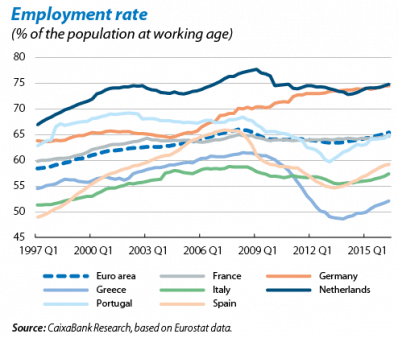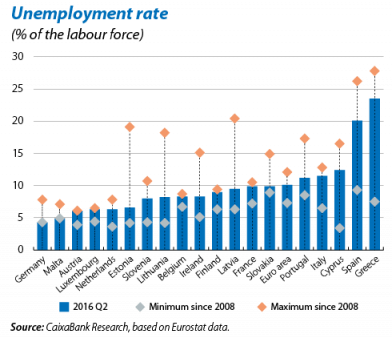Labour markets in the euro area after the crisis: a reality-check
Employment has been recovering in the euro area since 2013 and is expected to reach its 2008 pre-crisis level by the end of 2016 with around 154 million people in work. This recovery is still incomplete, however, and is occurring at different rates depending on the country in question, resulting in a highly heterogeneous labour market.
In 2016 Q2 the employment rate was once again above 65% in the euro area on average, a similar level to 2008. The situation in countries such as Germany is very good: its employment rate exceeded 74% in 2016 Q2 (4 pps more than in 2008). But this scenario is far from widespread and employment rates are almost 6 pps lower than their pre-crisis level in particularly the peripheral countries, especially in Greece with a rate of 52.1%, almost 10 pps below its 2008 level. If we consider that a country’s employment rate is a measure of how much the economy’s human capital is being utilised, peripheral countries are making much less use of this resource than Germany or the Netherlands.
Variations between countries in terms of the duration and impact of the crisis and also in terms of the intensity of their recovery have accentuated the differences in unemployment rates even further. In the euro area as a whole, unemployment has fallen slowly but steadily since 2013, reaching 10.1% in 2016 Q2 (although it is still 3 pps higher than in 2008). Germany’s low unemployment figure (4.3%) means that the country’s situation can be classified as almost full employment in practical terms, when the remaining unemployment is merely frictional, due to the time taken by workers to move from one job to another. But other countries such as the Netherlands and France and especially those on the periphery are finding it difficult to reduce their unemployment rate to its pre-crisis level. The unemployment rate in Italy, Spain and Greece is still very high: at 5, 10 and 16 pps above the levels of 2008, respectively.
The people most affected by job losses are those less qualified, younger and/or less experience. For example, youth unemployment (those aged between 15 and 24) is more than double the general unemployment rate (20.9% in 2016 Q2) and reaches even more alarming levels in the periphery, close to 50% in Greece and Spain, 36% in Italy and 27% in Portugal. Another consequence of the prolonged economic crisis is that an increasing proportion of unemployment is long-term: in the euro area one out of every two unemployed people have been out of work for more than a year. This is particularly serious because the longer an individual is unemployed, the harder it is for them to find another job.
One piece of good news in this scenario is the continued increase, widespread among all countries, of participation rates between 2008 and 2016, reaching 72.8% of the working age population in 2016 Q2 for the euro area as a whole. This increase is due to structural factors such as the greater participation of older people but should be accentuated to be able to counter the effects of an ageing population.1
In conclusion, the panorama we have briefly described shows us that, although employment has reached a similar level to before the economic crisis, there is still a long way to go before we can ascertain a widespread recovery in the euro area’s labour markets.
1. See «The 2015 Ageing Report» by the European Commission.




